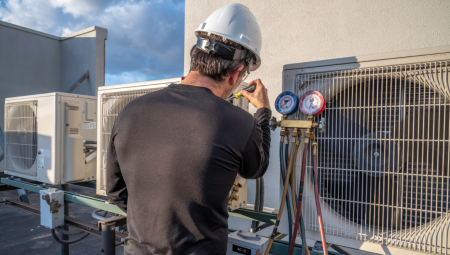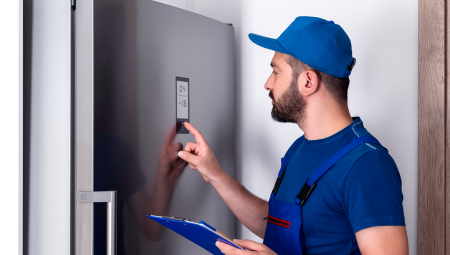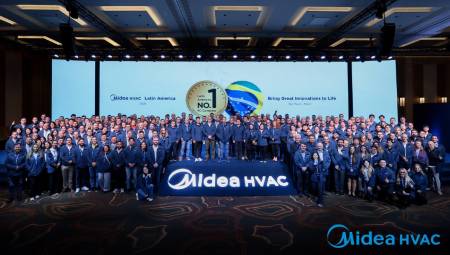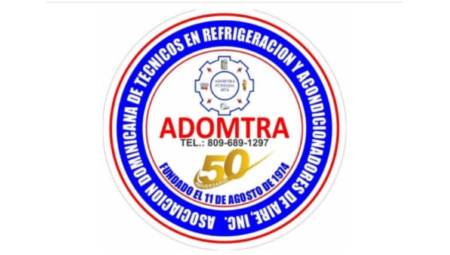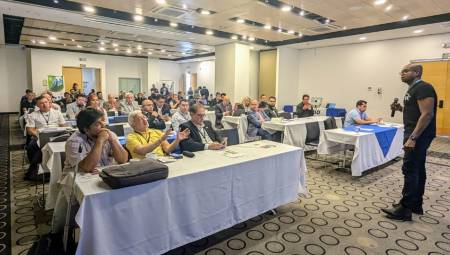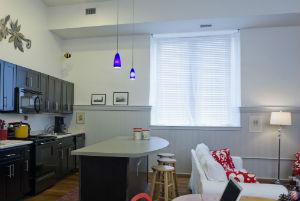 VRF systems continue to stomp as an option for the air conditioning of buildings, below we present two examples of installations with this technology.
VRF systems continue to stomp as an option for the air conditioning of buildings, below we present two examples of installations with this technology.
by Mitsubishi Electric
We present two case studies carried out in the United States where Mitsubishi Electric VRF type air conditioning systems were installed: the first of them in an office complex located in Baltimore; the second a school from the 1950s converted into apartments.
Union Mill
An adaptive remodeling project turned Union Mill, a 26,200-square-meter historic complex located in Baltimore, into a vibrant mixed-use complex. The complex consists of 56 apartments, one and two bedrooms, intended for teachers newly arrived in Baltimore. In the remaining space, 9,140 square meters, there are offices of educational, health and non-profit institutions in the city, as well as a restaurant of 460 square meters.
The challenge
The design team had to solve a number of problems when specifying the CVAC system. It had to take visibility into account for the location of mechanical equipment in and around the 146-year-old structure, as well as Baltimore's zoning and noise restrictions. The building had a gable roof, which did not serve to install boilers, coolers or outdoor condensing units, as well as thick stone walls that made the installation of ducts impossible. A conventional split heat pump system would require up to 160 individual units of split system that would be impossible to hide. Locating 160 outdoor units in the courtyard or behind the building was not an option, so a conventional split system with heat pumps was out of the question.
The solution
Consultants Allen & Shariff Engineering and distributor Aireco Supply suggested a VRF (variable coolant volume) zoning system from the Mitsubishi Electric US Cooling & Heating Division (Mitsubishi Electric). They determined that no other type of CVAC system could meet the particular needs of Union Mill.
The result
With the help of the VRF zoning system, Union Mill was the first project certified with the Baltimore City Green Building Standard. The project's developers, Seawall Development Company (Seawall), secured a cash rebate of $164,258 from the city's Baltimore Gas & Electric's Smart Energy Savers Program.
"This is a fantastic system," said Evan Morville, a partner at Seawall. "Everything in the building is electric, and thanks to the ingenious design of Mitsubishi Electric's variable-speed compressors and heat exchangers, the average energy consumption of an apartment is only $50 a month."
Doan Apartments
Converting a Victorian-era school with two 1950s additions into a multifamily facility was the challenge faced by the Famicos Foundation (Famicos), a nonprofit construction company that develops affordable housing, and Cleveland-based construction firm City Architecture. The goal was to make 45 senior apartments at Cleveland's Doan School, which is listed on the National Register of Historic Places.
The challenge
The old wooden roof had allowed water to filter on all levels of the building, this had to be extracted. It was necessary to remove the old boilers and wall air conditioning units. The project required a new CVAC system.
The solution
"For this demanding historic installation, Mitsubishi Electric's VRF zoning design team had to solve a large number of problems," said mechanical engineer Joe Denk of Denk Associates. In addition to the great flexibility of the pipe design and wiring of the VRF zoning system, the size of the units, both of the outdoor compressors and the indoor air conditioning units, played an important role in the process of transforming the old school space into residential apartments. I don't know of any other system that would make these adjustments possible.
Due to the building's huge windows, wide hallways, and 3-meter-high skylights and ceilings, Denk was concerned that vertical air conditioners that had been installed in cabinets might not provide the proper heat level. However, their concerns dissipated as soon as the system began to work. "Mitsubishi Electric's design circulates air very efficiently," he said. "The VRF zoning equipment is extremely quiet and features excellent quality fans, controls and conditioning functions."
The result
The system helped Famicos earn Ohio State's Enterprise Green Communities sustainability certification. The Doan Apartments also received an $8,000 rebate from Cleveland's Public Power's Efficiency Smart energy efficiency program, and each apartment achieved an 85-100 rating in the Residential Energy Index (HERS) program, equivalent to that of new construction.
Conclusion
VRF zoning systems provide a high-quality cooling and heating solution that meets the demands of multifamily housing construction. They offer individual control of comfort, energy efficiency, compact size, installation flexibility and ease of maintenance. These features result in benefits for occupants, including increased comfort and reduced utility bills. Multifamily home builders also benefit from the potential for sustainable building certifications, a reduction in maintenance costs, and an increase in rental space.
VRF in multifamily applications
Multifamily applications have numerous cooling and heating requirements that a CVAC system must meet. Requirements include the need for flexibility in maximum load, individual comfort control, energy efficiency and ease of installation and maintenance. Installing a high-quality cooling and heating system, such as a VRF zoning system, solves many of these challenges. The systems reduce utility costs and raise occupant comfort levels, which can lead to an increase in occupancy rate, reduced turnover, an advantage over the competition and, in some cases, an above-average rent.
Maximum load flexibility: In multi-family buildings, the fact of not knowing for sure the hours of occupation makes it difficult to estimate the maximum demand or energy use. In addition, it is difficult to predict the amount of energy that occupants will use in a given unit. The variable speed compressors of VRF zoning systems adjust to different partial and total load conditions, making them ideal for multifamily applications where energy usage schedules are unpredictable.
Space saving: The systems require few or no ducts, depending on the interior units selected, which maximizes the use of square meters. Duct reduction makes it possible to install the systems in buildings without duct systems, or to recover spaces that were previously dedicated to larger mechanical systems. The compact size of the outdoor units allows the elimination of engine rooms, thanks to which it is possible to free up additional rental space indoors. Outside, the units are much smaller than conventional boiler/chiller systems. Consequently, less rooftop or ground-level space is needed for condensation units. Building owners and builders can use the extra rooftop and outdoor space for community activities, incorporating rental or recreation spaces.
Modernization possibilities: More than half of the multifamily units in the United States are more than 30 years old, and have CVAC systems just as old. VRF zoning systems are ideal for building modernization applications. The modular, flexible and low-impact design allows the installation of a modern CVAC system, while preserving the architectural integrity of the space.
Maintenance: The systems are easy to maintain. A unit can be repaired without having to disconnect the entire system, so the inconvenience caused to tenants is minimal. Indoor units feature washable filters that are easy to clean or replace.
Individual comfort control: The systems provide each unit of the tenants and the common areas with their own comfort control system. The system increases occupant comfort and decreases maintenance complaints. The centralized building management software allows to control the installed units that are not being occupied. Additionally, such software can monitor and control systems remotely via a smartphone or other devices with Internet access.





